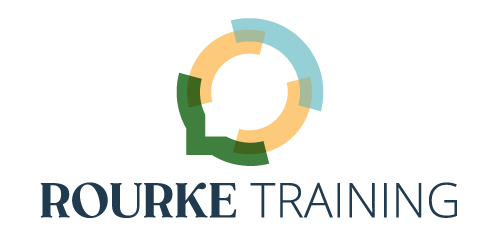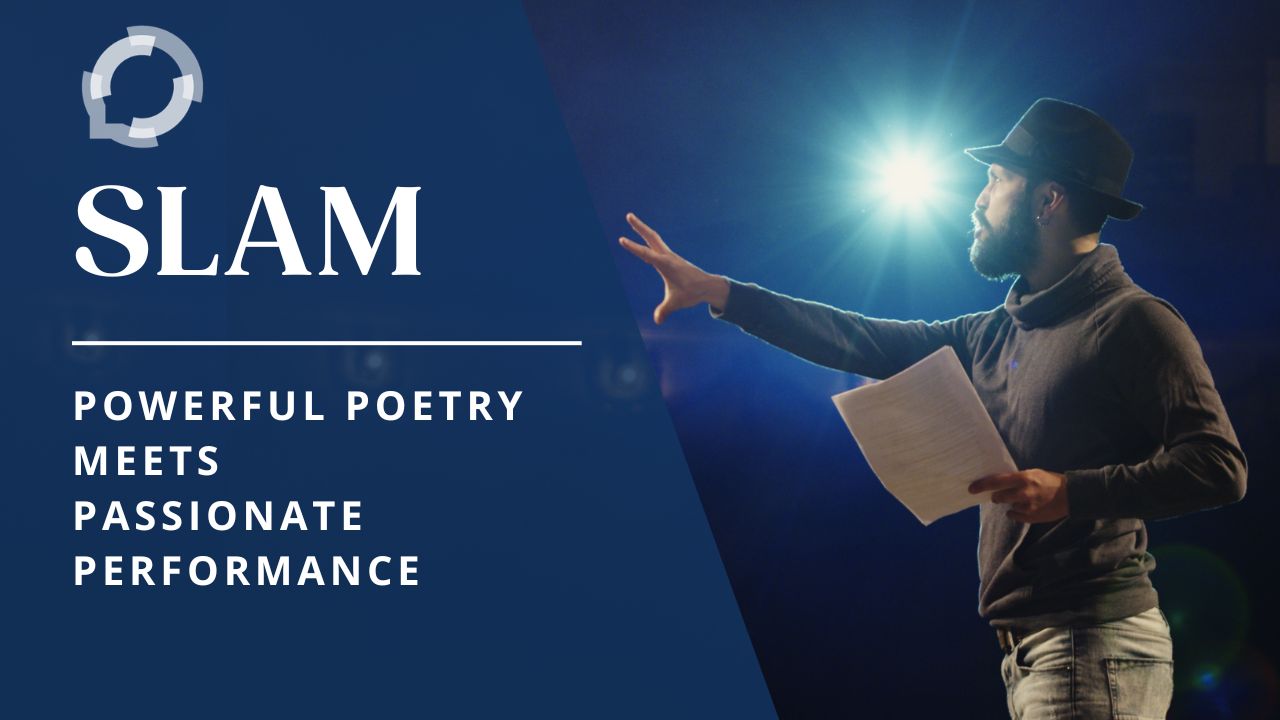You’re at a small performance venue, perhaps there’s a small stage, but perhaps there’s just a microphone and nearby stool. The lights are dim and the crowd murmurs with quiet anticipation. When the emcee announces the next performer, cheers and loud applause erupt, replaced by periodic whoops and finger snaps of approval throughout the brief show. This cycle repeats with every speaker of the evening. If this doesn’t sound like any poetry event you’ve imagined, then you haven’t experienced slam poetry.
April is National Poetry Month. This week, I’m highlighting the dynamic performance style that is slam poetry. If the term “poetry” only calls up images of dusty books, tweed jackets with leather elbow patches, and slow, careful elocution, seek out slam poetry for an entirely different understanding of the power of language to move both artist and audience.
At its core, slam poetry is a poet performing their own work in front of an audience. “Performing” is key, since slam poetry goes far beyond reading the words aloud. A slam performer uses their whole body, gesturing and moving around the stage, deploying their full vocal range, pitch, and volume to emphasize their emotions.
Nor is the audience silent until applauding politely at the poem’s conclusion. A slam poetry audience responds in the moment with the performer, clapping or snapping, quietly or loudly saying “yes,” perhaps just expressing nonverbal “mmmms” of agreement. That mutual investment in the performance is a key aspect of slam poetry.
Slam Poetry on My Syllabi
I first learned of slam poetry when someone sent me a video of Taylor Mali performing his work, “What Teachers Make.” I watched it repeatedly back to back at least 5 times, and every day for a week after that. I still watch the video regularly, especially when I’m stressed about teaching or having a difficult semester. Though Mali speaks about his experience as a high school teacher, his slam performance captures the passion and commitment that keeps me in the college classroom.
Since then, I’ve used clips of slam poetry in my course on fairy tales. Miriam Sachs’ “26 Seconds” is a terrific companion piece/counterpoint for a short story that’s long been on my writing syllabus. I really love Phil Kaye’s “Beginning, Middle & End” for talking about narrative and structure as students figure out their own literacy stories for our first assignment.
When public speaking was part of the first year writing curriculum on my campus, Taylor Mali’s “Like Totally Whatever” was useful for opening a conversation about the ways that others perceive students’ speaking habits, especially the generation or two older than they are who’ll be hiring them in the future.
And yet, why is there just one way to sound authoritative, the model having been set for what an “educated” person sounds like when only rich white men went to college? Melissa Lozada-Oliva’s rebuttal to Mali, also called “Like Totally Whatever,” is a bracing feminist clarion call to diversity, individuality, and authenticity. As I would tell my students, find your voice, use it, and know the contexts in which you speak.
An Oral Tradition
Slam poetry continues a long tradition of poetry performance.
While we don’t know whether Homer was one poet or a name for a group of poets who produced The Iliad and The Odyssey, we do know that both were both composed and performed orally, before the invention of written Greek. Some of the hallmarks of epic poetry reflect this spoken milieu. Features such as repeated tag phrases associated with main characters and circumstances, lists of people and goods, and an invocation to the Muse to help the poet sing are all characteristics that buy the speaker poet a few seconds of additional time, so they can continue the performance while recalling – or making up – the next section.
For generations of Americans, poetry recitation was a required element of elementary and secondary education. Focusing on memorization as a tool of academic discipline, recitation unintentionally turned many off to the joys of spoken poetry. A shift to performance, on the other hand, has reinvigorated this classroom technique, giving students a chance to really invest themselves in the process and experiment with voice. Poetry Out Loud gives high school students the opportunity to compete for cash prizes, modest at the state level, significant at the national level.
As I mentioned previously, several American presidents have invited poets to perform as part of their Inauguration Day celebrations. Amanda Gorman, National Youth Poet Laureate, is an especially powerful example of bringing the whole body to poetic performance. In “The Hill We Climb” for President Biden’s Inauguration in 2021, Gorman had an almost dancerly grace in her gestures, her hands as important to her performance as her voice.
The Origins and Future of Slam Poetry
As a performance genre, slam poetry arose in Chicago in the 1980s when Marc Kelly Smith created the first slam events. The format especially emphasizes openness and diversity across all identities and topics, as Walter Gonzales has noted, though the poems should be the performer’s own works. Equally important, slam poems are short, typically 3 minutes or shorter. Slam has a significant home at the Nuyorican Poets Café in New York City, having hosted NYC’s first poetry slam in 1989; slam is thus connected to the earlier beat and Négritude poetic movements of the city.
From its American roots, slam poetry has grown into a global movement. The World Poetry Slam Organization is “a worldwide organization aimed at the diffusion and prosperity of Poetry Slam and its community and family spirit.” The WPSO’s manifesto is a declaration of advocacy, support, and respect, explicitly both on and off the slam stage. The 2024 global competition will be in Togo.
How About You?
Did you have to memorize and recite poems in school? How was that experience? Were you allowed to choose the poem you performed? Incorporate body movement and vocal range? Whether or not you’ve memorized it, do you have a favorite poem to recite? Something that you enjoy rolling around in your mouth before giving it voice and releasing to the world?
I’ve never acted on a stage, but I love Macbeth’s soliloquy upon hearing that Lady Macbeth, his wife and full partner in their greed for power, had just died by her own bloodied hand. Famously beginning “Tomorrow, and tomorrow, and tomorrow / Creeps in this petty pace from day to day, / To the last syllable of recorded time,” the lines are evocative, melancholy, melodramatic, bitter, and perhaps even a smidge self-deprecating (Mabeth, Act 5, scene 5, lines 22-30).
Have you attended a poetry slam? What was it like? Were you there to see a specific performer? What did you think about the audience-engagement aspect of the evening? I’d love to know if the audience you were part of maintained an even level participation throughout, or if the momentum built up, as often happens at stand-up comedy shows, for example.
Tell us about it in the comments.
Check Out Our YouTube Channel
The Rourke Training – Ongoing Mastery YouTube channel has a bit of something for everyone. Go there to get Kirsten’s take on examples of public speaking, as well as reflections on her entrepreneurial journey. The channel is also the home of the podcast Kirsten and Kellie produced for 5 years, Ongoing Mastery: Presenting & Speaking, which covers everything connected to continually improving your craft of being a public speaker, from interviews and mini-coaching sessions with guests to conversations between Kirsten and Kellie.
Come join us. Cheers, Kellie


